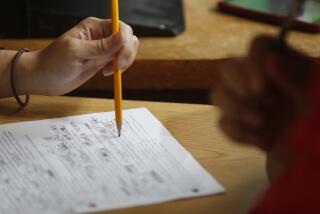Watching Memories in the Making
- Share via
Few things are so intangible yet so concrete as a vivid memory; few so easily elude sustained study by scientists. To search systematically for a single memory in the brain is to rummage blindly in the cabinet of the imagination.
Until recently, brain experts could track the anatomical traces of human memory only indirectly by studying people whose memories were selectively damaged by strokes or head injuries.
But now, researchers are using new technology to probe ever deeper into the labyrinth of the human brain.
On just such a journey, three UCLA scientists exploring the exposed tissue of the living human brain recently gained an evocative glimpse into how individual brain cells can remember what the conscious mind has forgotten.
Using electrodes to eavesdrop on the human brain at work, UCLA neurosurgeon Itzhak Freid and his colleagues Katherine A. MacDonald and Charles L. Wilson for the first time recorded electrical signals from individual neurons involved in making long-term memories.
They discovered that an individual neuron appears to retain the raw material of a memory long after any conscious recollection of it has faded. This offers tantalizing insight into how the distinction between conscious and unconscious memories may arise.
Their discoveries about neurons and learning, published recently in the journal Neuron, are a key step toward understanding how millions of individual brain cells together can be organized into a code to make up a single complex memory, like daubs of paint in a pointillist painting.
“The challenge of neuroscience is to figure out how this code works,” said Freid. “There is a lot of information that is processed by a single neuron.”
*
While emotional and factual memories appear to join seamlessly in our conscious experience, the physical anatomy of memory varies dramatically, depending on the kind of recollections involved, cognitive neuroscientists determined.
Personal memories of everyday events and short-term working memories--like a telephone number or a phrase from a passing conversation--may be stored through the hippocampus, while the lifetime accumulation of factual knowledge--called semantic memory--may be lodged elsewhere. Unconscious skills--like the ability to drive, speak a second language or juggle bowling pins--are handled in yet another way, researchers believe.
The memory of words appears to go one place, while the memory of the objects with which they are associated is stored somewhere else. Faces, letters and colors are handled by different parts of the cortex. Even for a single face, the coding for identity, gender and expression are all represented individually.
Today, sophisticated brain scanning devices allow researchers to trace broad circuits of memory, as fleeting patterns of human thought activate different portions of the brain. But even these techniques--based on patterns of blood flow--do not allow researchers to pinpoint directly the precise cells involved in creating the unique pattern of a recollection.
To investigate how individual neurons encode memory information, the UCLA researchers took advantage of an unusual group of volunteers awaiting brain surgery.
*
In all, they studied nine patients preparing for neurosurgery to correct severe epilepsy. As part of the normal preoperative procedures, they had electrodes implanted in their brains to help guide surgeons to the focus of the seizures.
Such patients often must wait up to a week while the seizure areas of their brain are located. The men and women are conscious all the while; so the electrodes, implanted in areas of the brain responsible for memory and social behavior, also offer a rare opportunity to watch the brain at work.
To investigate how learning takes place in individual neurons, the researchers used the electrodes to record the cell’s electrical activity as the patients studied a series of faces, emotional expressions and objects.
Probing each cell, the researchers quickly deconstructed the cellular mosaic of memory into its smallest components. Each neuron, they found, was a specialist.
*
Some individual neurons could distinguish a face from an object, they determined. Others responded only to a particular expression, such as sadness, but were unmoved by expressions of surprise or happiness or fear. Some responded to male faces, others just to women. Others keyed to an individual’s identity.
As they probed, they discovered other neurons that only responded to combinations of faces and emotions, which would, for instance, respond to angry faces but only if they were female. “A single cell would respond to an angry woman and nothing else,” Freid said.
To test how long the memories were retained, the researchers waited 10 hours and then ran each patient through another round of tests to see what they recalled.
Much to their surprise, they discovered that the chemical and electrical structure of an individual neuron retained the pattern of a memory long after the ability to retrieve that memory had been lost. In a sense, an individual neuron appeared to maintain a record of past experience that may be more accurate than the person’s conscious recollection, the researchers found.
“We were expecting the cells to follow religiously the conscious recollection,” Freid said. “But the story is not that simple.
“The neuron knew better,” he said. “That relates to the issue of conscious and unconscious memory processes.”
Freid suggested that each conscious memory may be the result of a critical mass of its component neurons. Even if a majority of the cells have lost the chemical and electrical pattern of a particular memory, it may linger in a significant minority, Freid speculated.
“The majority can be wrong, but the individual neuron can be right,” he said.
(BEGIN TEXT OF INFOBOX / INFOGRAPHIC)
Lasting Impressions
UCLA researchers for the first time have recorded individual human brain cells involved in learning and memory.
Some brain cells respond only to an emotion, while others respond to gender or identity. Some only respond to combinations of all three.
* The colored grid at right shows how a single neuron in the hippocampus of the brain reacted when exposed to combinations of facial expressions and gender. The grid records the intensity of its response to each combination; the responses range from indifference (blue) to highly intense (red).
* This one brain cell has been taught to respond most strongly to the face of an angry woman. The intensity of the red indicates how strongly the cell reacted to the one combination it remembers.
Source: UCLA, Neuron






